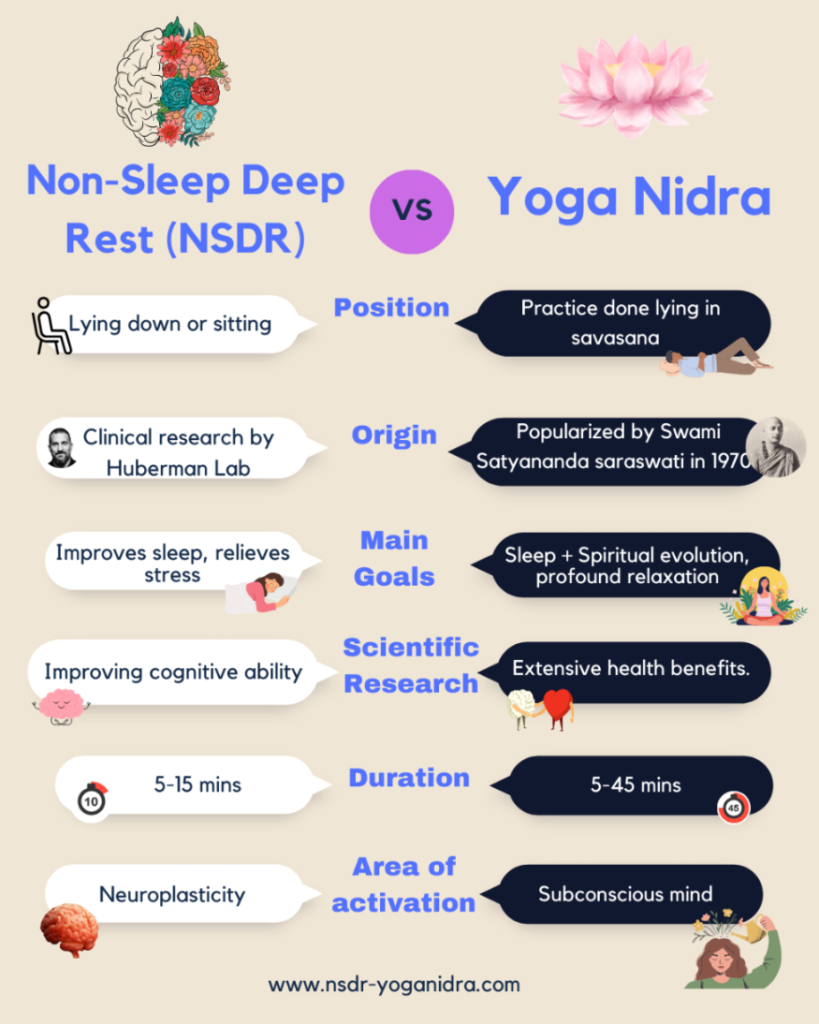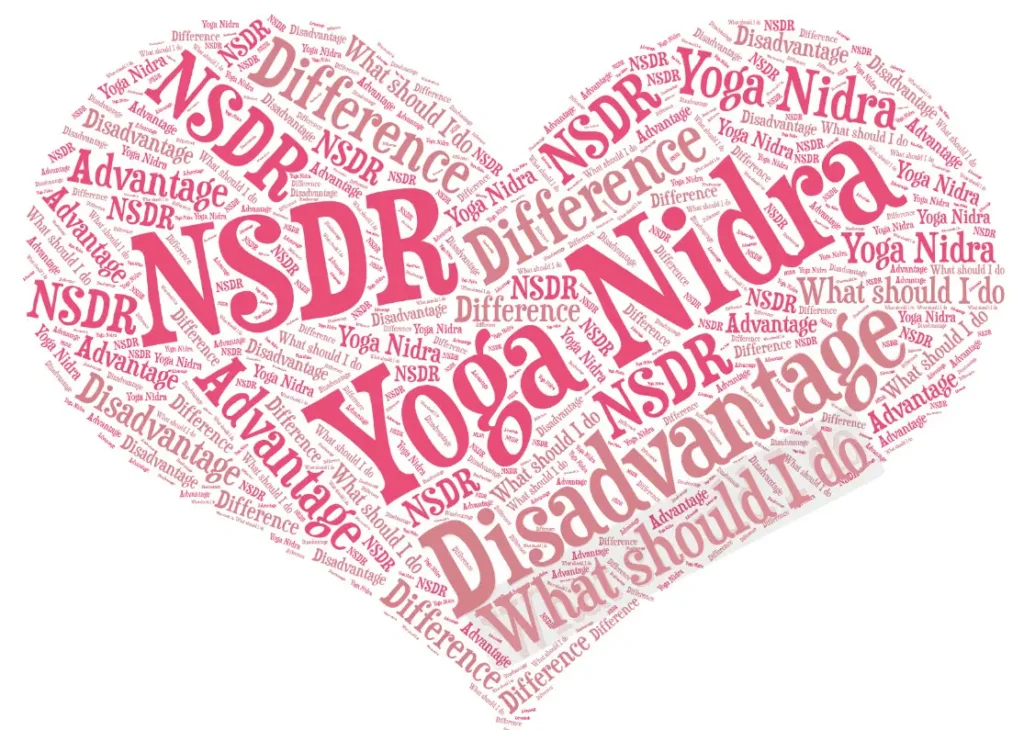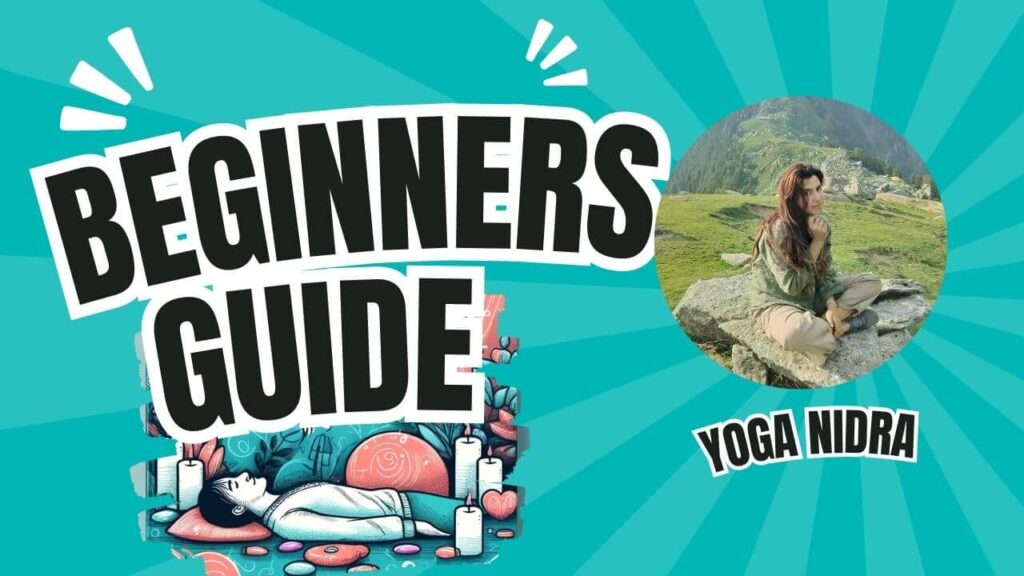Yoga nidra and Non Sleep Deep Rest(or NSDR) are both forms of relaxation techniques to ‘still’ the mind and tap into the inner-calm, but are they the same? Is one better than the other? Read on below.
Non-Sleep Deep Rest (NSDR) is a practice of mindful relaxation coined by neuroscientist Andrew Huberman, the roots of which are in the ancient Yogic practice of Yoga Nidra or yogic sleep.The term caught on and the Internet is divided in to the difference between two. As we like to put it, do you want to go to Holland or Amsterdam? Is like choosing between Yoga Nidra and NSDR.
They have so many similarities, though still not the same. Let’s discover what makes them different.Below we have broken the difference between, non-sleep deep rest (NSDR) and yoga nidra are not the same. Let’s break down the differences.
NSDR Vs Yoga Nidra: Are they the same? Which is better?
A very wise person recently said, “NSDR is fundamentally a present day description and application of the ancient, traditional practice of Yoga Nidra.”

In the hustle and bustle of modern life, stress and anxiety have become constant companions, taking a toll on our well-being. Fortunately, there are powerful relaxation techniques that can bring deep rest and rejuvenation. Join us as we delve into the incredible benefits of Yoga Nidra by Swami Satyananda and Non-Sleep Deep Rest (NSDR) by Andrew Huberman. In this blog post, we will explore the origins, methodologies, and clinical advantages of these practices, supported by scientific evidence.

Are Yoga Nidra and NSDR the Same?
Yoga Nidra and NSDR are different in their positioning and below are outlined key differences with details
Non-Sleep Deep Rest (NSDR): This relaxation technique, endorsed by Andrew Huberman, has garnered popularity. However, it has still to garner a well-established philosophical background and standardized methodology is still in process. This form has been endorsed by neuroscientist Andrew Huberman, NSDR or NSDR Huberman offers a modern, accessible form of relaxation without a well-established philosophical background. We have also compared NSDR vs Meditation, benefits and differences in a seperate article.
Basically, NSDR can refer to the whole spectrum of ‘deep rest techniques’ and even practices like guided focus techniques(dharana practices in yogic terminology) breathwork, relaxation to sounds, visualizations, self hypnosis can come within this arena.
Sunar Pichai Google CEO mentioned that often when he found it difficult to meditate, he would simply find a NSDR video on youtube and follow along. However, it has still to garner a well-established philosophical background and standardized methodology is still in process.
There are 3 easy NSDR protocols that are available online:
- NSDR for a short nap– to leave you re-energised
- NSDR Yoga Nidra – brings about calm and initiates relaxation
- NSDR and Hypnosis – emotional release, brings lightness in the body and creates healing.
The main focus of NSDR is to ‘facilitate lost sleep, bring about recovery, nervous system reset, vagus nerve activation, focus neuroplasticity and more. This is the perfect sauce for the new age man who has less time on his hands, no knowledge of sanskrit and wants to optimize their day with 100 different tasks but still not lose energy and focus.
Yoga Nidra: ‘The modern form of the technique, was pioneered by Dennis Boyes in 1973, made widely known by Satyananda Saraswati in 1976, and then by Swami Rama, Richard Miller, and others has spread worldwide.’
This is how he described the practice:
“Relaxation does not mean sleep. Relaxation means to be blissfully happy; it has no end. I call bliss absolute relaxation; sleep is a different matter. Sleep only relaxes the mind and senses. Bliss relaxes the atma, the inner self; that is why, in tantra, Yoga Nidra is the doorway to the bliss of Samadhi.”
– Swami Satyananda Saraswati, Yoga Nidra, pub. Bihar School of Yoga, 1976.

The purpose of the practice was the attainment of Samadhi or the highest form of self-realization. In this sense philosophically, both NSDR and Yoga Nidra have two separate end goals, however NSDR has been packaged and evaluated under a trained eye in an attempt to make the practice universal and applicable to modern man with no ‘yogic terminology’ and easy soft and endearing tonality that brings one into a sense of peace quickly.
Yoga Nidra has many benefits which can be seen as reduction of pain, enhanced learning, improved memory and cognition, emotional self regulation and more. It is done under the guidance of a supervisor or a trained teacher and this form of meditation is mostly done sleeping or in ‘Shavasna’ while NSDR gives you an option to sit or lie down according to your own comfort.
What Sets Yoga Nidra and NSDR Apart?
Goal of Yoga Nidra & NSDR:
Yoga Nidra: As we discussed, The primary goal of Yoga Nidra is to induce a state of profound relaxation, self-awareness, and inner healing through access to the subconscious mind.
NSDR: On the other hand, NSDR, endorsed by Andrew Huberman, aims to provide deep rest to the body and mind while staying awake. However, its clinical benefits await further neuroscience research. This is still a fairly new space of research.
Yoga Nidra vs NSDR juxtaposes in its very definition and origin– Yoga Nidra, rooted in ancient practices, offers profound relaxation and self-awareness, while contrasting NSDR’s focus on efficient, modern relaxation”. Therein lies their biggest difference. Andrew Huberman too mentions that his NSDR is derivative of the Yoga Nidra and other ancient breathwork practices but evolved to grow outside of the scope of just yogic practices and into other scientific modalities such as hypnotherapy and visualization
Common Misconception – Yoga Nidra vs. NSDR
While NSDR has gained attention, it is essential to consider that Yoga Nidra under Swami Satyananda benefits from extensive scientific research conducted under the Bihar school of Yoga, Munger and by other researchers world over. This practice has definitely stood the test of time. Studies show its effectiveness in reducing stress, anxiety, depression, and enhancing sleep quality and overall well-being. In Yoga Nidra there is a whole philosophical context of chakras, koshas, elements etc that teachers can build resources around, while NSDR doesn’t have this philosophical and scriptural context.
However, NSDR scientific benefits outweigh the lack of time duration the NSDR classification has existed. NSDR’s Memory enhancing capacity reflects that though less established than Yoga Nidra, it aims to “enhance memory and cognitive functions through deep rest and relaxation” which is scientifically measurable.
NSDR is also a learning tool as you will see below. Its modern approach to relaxation and mindfulness potentially supports enhanced learning and focus in everyday tasks”.
Yoga Nidra, with a rich philosophical context, has been shown to improve learning, memory, and emotional regulation through deep meditative states”.
Exploring the Clinical Benefits – Link Back to Our Papers
Research on Yoga Nidra, as supported by numerous studies, showcases its positive impact on the autonomic nervous system, fostering better physiological and psychological outcomes. You can read about Yoga nidras effect on Insomnia here.
In contrast, NSDR is a newer practice, and further neuroscience research is required to fully comprehend its clinical advantages.
Is Yoga Nidra dangerous?
When it comes to safety in practice of Yoga nidra, there are numerous benefits; however, it must be mentioned that if one is undergoing any sort of treatment or has a clinically diagnosed issue, YOga nidra and NSDR is best done under guidance.
Yoga nidra has many levels of practice and while practising the basic levels, an audio or self practice may feel alright, when one is going deeper into the states within the subconscious mind, a senior teacher and facilitator must always be present for guidance since we (the person practicing the Yoga nidra or NSDR) is usually in that mid sleep-awake state and cannot self regulate in those deeper states.
Clinically speaking, Yoga nidra and NSDR practices are safe and induce great relaxation, however, guidance from expert must be sought from time to time to make sure one is on the right track to achieving the goals that you set out to achieve in the first place- eg: Yoga nidra and NSDR for memory enhancement, greater calm, balancing emotions etc.
When to Embrace Yoga Nidra & NSDR:
To make the most of these practices, consider your preferences and needs. If you seek a structured and well-documented relaxation technique, the time-tested and revered Yoga Nidra is an ideal choice. On the other hand, if you are open to experiences and new relaxation methods, NSDR endorsed by Andrew Huberman might pique your interest. An NSDR is usually shorter- between 10-30 mins, while a traditional Yoga Nidra practice may well exceed 45 mins.
Unlocking the Power of Neuroscience:
Numerous studies support the clinical benefits of relaxation protocols like Yoga Nidra and NSDR that impact memory, stress reduction, emotional regulation, and overall mental health.They both hold the promise of emotional self-regulation, neuroplasticity, resilience, creativity and more. The impact is on so many deep levels.
A Journey into Deep Healing and Rest – NSDR:
Unlock the potential of Non-Sleep Deep Rest (NSDR) by Andrew Huberman with his expert endorsement. Experience a deep state of healing and rest through this special, fun and quick relaxation technique. Feel revitalized and recharged, as if you’ve enjoyed a restful sleep for hours. Embrace NSDR anytime during the day for a quick boost or in the evening to enhance deep sleep.
This Non sleep deep rest is at the intersection with Yoga Nidra and what makes it so unique. Andrew Huberman’s NSDR is designed to facilitate recovery and focus neuroplasticity, appealing to those with limited time and no background in yogic practices
In Huberman’s NSDR the idea is to focus on the voice guiding you- often focussing on the different parts of your body, grounding you into the physical world, creating a safe and all encompassing environment to give you this healing experience. Yoga Nidra too asks you to ‘focus’ on the sound of the voice and this one pointed focus somewhere along the practice helps you create a bridge into your subconscious mind. Just like hypnotherapy speaks to your subconscious, so does Yoga Nidra.
The only difference here is that Hypnotherapy get you to go into REM or rapid eye movement at the beginning of the session, while Yoga Nidra doesn’t always do this, however, they too have visualizations where one focuses between the eyebrows at a candle flame before lying down for the beginners level Yoga Nidra so that wwe can really gather our attention and learn to focus the mind.
There are so many subtle similarities in this vast ocean of non sleep deep rest, that whatever the intention, one does indeed learn to touch the iceberg of mind mastery. These practices are easy, simple and one does not need anything except the investment of a little undisturbed time set aside,even if it is as little as 10 mins.
Conclusion on Yoga Nidra Vs NSDR – The Raging debate on Internet
Yoga Nidra and Non-Sleep Deep Rest (NSDR) traverse a very gray area of powerful relaxation techniques that can lead to profound healing and rejuvenation. Embrace the rich history and scientific backing of Yoga Nidra, or explore the trendy and refreshing experience of NSDR. Regardless of your choice, both practices hold the promise of enhanced well-being and inner peace. Unleash the transformative power of relaxation in your life and experience the incredible benefits supported by neuroscience. In my own practice at Sleep Dragon we are the cusp of Yoga Nidra and NSDR.
NSDR Protocol is still developing its standardized methodology, encompasses a variety of deep rest techniques including breathwork and self-hypnosis and interestingly even though Yoga Nidra has its set rules, teachers are still evolving in their teachings within Yoga nidra too. Not to be confused with ASMR (Autonomous sensory meridian response) where people speak in soft voices or enjoy the sensation when there are other instruments/ props being used, there have been many advocates and teachers who have used soft soothing ASMR tones to lull people into Yoga Nidra.


